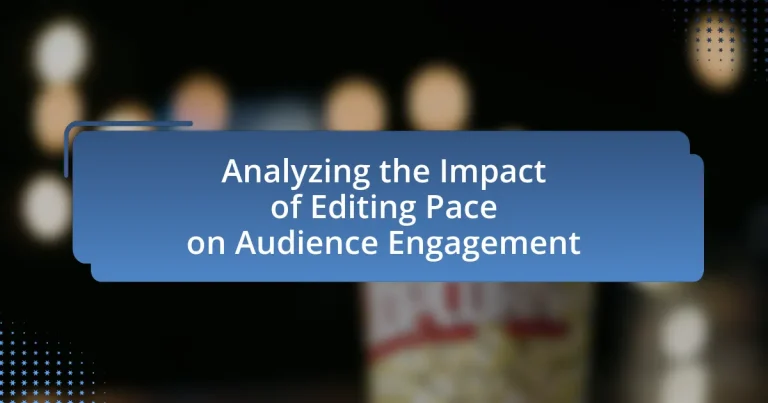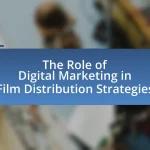The article analyzes the impact of editing pace on audience engagement, highlighting how different editing speeds influence emotional responses and viewer perception. It discusses the psychological effects of fast and slow editing, emphasizing that faster cuts can create urgency and excitement, while slower pacing fosters deeper emotional connections. The article also categorizes editing pace into fast, moderate, and slow types, examining their effects across various genres, including action and drama. Additionally, it explores best practices for optimizing editing pace to enhance viewer retention and satisfaction, supported by research findings on audience engagement metrics.
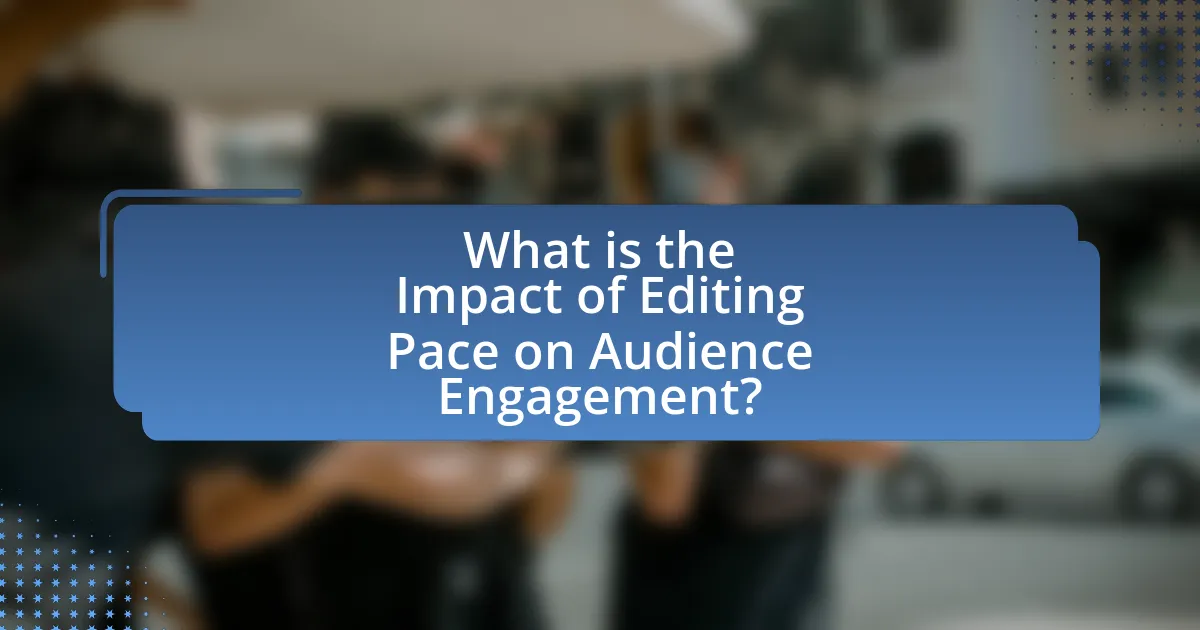
What is the Impact of Editing Pace on Audience Engagement?
Editing pace significantly influences audience engagement by affecting the viewer’s emotional response and attention span. Faster editing can create a sense of urgency and excitement, often leading to heightened engagement, particularly in action sequences or fast-paced narratives. Conversely, slower editing allows for deeper emotional connections and reflection, which can enhance engagement in dramatic or contemplative scenes. Research indicates that films with a higher frequency of cuts tend to maintain viewer interest, as evidenced by a study published in the Journal of Media Psychology, which found that rapid editing styles can increase physiological arousal and viewer retention. Thus, the editing pace directly correlates with how effectively an audience connects with and remains engaged in the content.
How does editing pace influence viewer perception?
Editing pace significantly influences viewer perception by shaping the emotional and cognitive engagement with the content. A faster editing pace often creates a sense of urgency and excitement, which can heighten emotional responses and maintain viewer attention, as evidenced by studies showing that rapid cuts in action sequences can increase adrenaline levels and viewer arousal. Conversely, a slower editing pace allows for deeper contemplation and emotional connection, as seen in dramatic scenes where prolonged shots enable viewers to absorb character emotions and narrative depth. Research indicates that editing pace directly affects how viewers process information, with faster edits leading to superficial engagement and slower edits fostering critical thinking and reflection.
What psychological effects does editing pace have on audiences?
Editing pace significantly influences audience engagement by affecting their emotional responses and cognitive processing. Faster editing can create a sense of urgency and excitement, often heightening adrenaline and engagement levels, while slower editing allows for deeper emotional connection and reflection. Research by the University of Southern California found that rapid cuts in action films can lead to increased heart rates and heightened arousal, indicating a direct psychological impact on viewers. Conversely, slower pacing in dramatic scenes fosters empathy and contemplation, as evidenced by studies showing that audiences retain more information and exhibit stronger emotional responses during longer takes. Thus, editing pace plays a crucial role in shaping how audiences experience and interpret visual narratives.
How does editing pace affect emotional responses during viewing?
Editing pace significantly influences emotional responses during viewing by altering the rhythm and intensity of the narrative. Faster editing can heighten tension and excitement, as seen in action sequences where quick cuts create a sense of urgency, while slower editing allows for deeper emotional engagement and reflection, often used in dramatic scenes to evoke empathy. Research by Zacks et al. (2009) in “Cognitive Science” indicates that viewers’ emotional responses are closely tied to the pacing of edits, with rapid cuts leading to increased arousal and slower cuts fostering a more contemplative emotional state. This demonstrates that editing pace is a critical tool in shaping how audiences emotionally connect with visual content.
Why is editing pace important in media production?
Editing pace is crucial in media production because it directly influences audience engagement and emotional response. A well-timed edit can enhance storytelling by maintaining rhythm and flow, keeping viewers invested in the narrative. Research indicates that faster editing can create a sense of urgency and excitement, while slower pacing allows for reflection and emotional depth. For instance, studies show that films with varied editing speeds can increase viewer retention and satisfaction, as audiences are more likely to remain focused when the pacing aligns with the content’s emotional tone.
What role does editing pace play in storytelling?
Editing pace significantly influences storytelling by controlling the rhythm and flow of a narrative. A faster editing pace can create tension and excitement, engaging the audience more intensely, while a slower pace allows for reflection and emotional depth, enhancing character development and thematic exploration. Research indicates that films with varied editing speeds can maintain viewer interest and emotional investment, as seen in studies analyzing audience reactions to different pacing techniques in cinema. For example, a study published in the Journal of Media Psychology found that rapid cuts in action sequences heightened adrenaline responses, while slower edits in dramatic scenes fostered empathy and connection with characters. Thus, editing pace is a crucial tool in shaping audience engagement and narrative impact.
How can editing pace enhance or detract from narrative flow?
Editing pace can significantly enhance or detract from narrative flow by controlling the rhythm and timing of the story’s progression. A faster editing pace can create urgency and excitement, engaging the audience by maintaining a high level of tension, as seen in action films where quick cuts heighten adrenaline. Conversely, a slower editing pace allows for deeper emotional resonance and character development, as demonstrated in dramatic narratives where lingering shots enable viewers to connect with characters’ internal struggles. Research indicates that editing pace directly influences viewer engagement; for instance, studies show that audiences are more likely to remain invested in a story that balances fast and slow pacing effectively, as it mirrors real-life experiences of tension and relief.
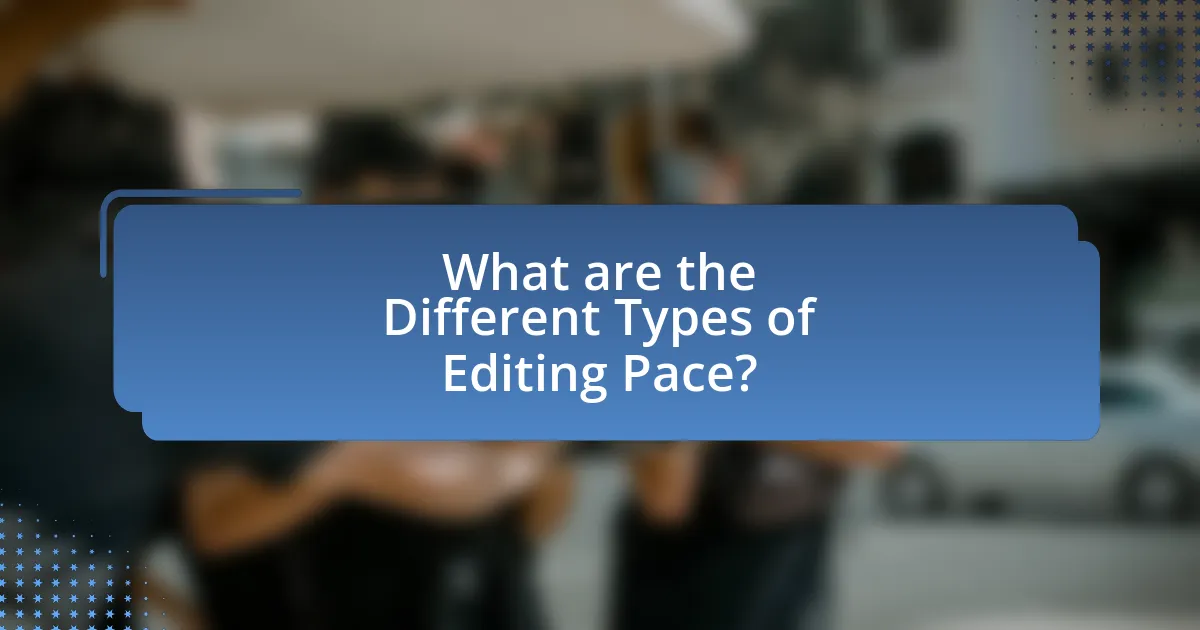
What are the Different Types of Editing Pace?
The different types of editing pace include fast, moderate, and slow editing. Fast editing typically involves quick cuts and rapid transitions, which can create a sense of urgency and excitement, often used in action sequences or trailers. Moderate editing maintains a balanced rhythm, allowing for character development and narrative progression, commonly found in dramas. Slow editing features longer takes and fewer cuts, which can evoke contemplation and emotional depth, often utilized in art films or reflective scenes. Each type of editing pace significantly influences audience engagement by shaping their emotional responses and overall viewing experience.
How can editing pace be categorized?
Editing pace can be categorized into three primary types: fast, moderate, and slow. Fast editing pace typically involves quick cuts and rapid transitions, often used to create excitement or urgency, as seen in action films. Moderate editing pace allows for a balanced rhythm, providing enough time for the audience to absorb information while maintaining engagement, commonly found in dramas. Slow editing pace features longer takes and fewer cuts, often used to evoke contemplation or emotional depth, as seen in art films. Each category influences audience engagement differently, with fast pacing heightening tension and slow pacing fostering reflection.
What are the characteristics of fast-paced editing?
Fast-paced editing is characterized by rapid cuts, quick transitions, and a high frequency of shots, which create a sense of urgency and excitement. This style often employs techniques such as jump cuts, cross-cutting, and montage sequences to maintain viewer engagement and enhance the narrative’s momentum. Research indicates that fast-paced editing can increase audience arousal and attention, as demonstrated in studies showing that viewers are more likely to remain engaged with content that features a dynamic editing style. For instance, a study published in the Journal of Media Psychology found that fast-paced editing significantly improved viewer retention and emotional response compared to slower editing styles.
What defines slow-paced editing in media?
Slow-paced editing in media is characterized by longer shot durations and fewer cuts, allowing for a more contemplative viewing experience. This editing style emphasizes character development and emotional depth, often seen in art films and dramas. Research indicates that slow-paced editing can enhance audience engagement by fostering a deeper connection to the narrative and characters, as viewers are given time to absorb and reflect on the content. For instance, studies have shown that films employing slow-paced editing techniques can lead to increased viewer retention and emotional resonance, as audiences are more likely to engage with the story on a personal level.
What are the effects of varying editing pace on different genres?
Varying editing pace significantly affects audience engagement across different genres. In fast-paced genres like action and thriller, rapid editing creates tension and excitement, keeping viewers on the edge of their seats, as evidenced by studies showing that films like “Mad Max: Fury Road” utilize quick cuts to enhance adrenaline. Conversely, slower editing in genres such as drama allows for deeper emotional connection and character development, as seen in films like “The Godfather,” where longer takes facilitate audience immersion in the narrative. Thus, the editing pace directly influences how audiences perceive and engage with the story, shaping their overall experience.
How does editing pace differ between action and drama genres?
Editing pace in action genres is typically faster than in drama genres. Action films often utilize rapid cuts, quick transitions, and dynamic editing techniques to create a sense of urgency and excitement, engaging viewers through heightened adrenaline. For instance, studies show that action sequences can feature cuts every 2-3 seconds, while drama films generally maintain longer takes, averaging around 5-10 seconds, to allow for character development and emotional depth. This difference in editing pace significantly influences audience engagement, as the fast-paced editing in action films keeps viewers on the edge of their seats, while the slower pace in dramas fosters a more reflective and immersive experience.
What editing pace strategies are effective in documentaries?
Effective editing pace strategies in documentaries include varying the rhythm of cuts, utilizing slow-motion sequences, and incorporating pauses for reflection. These strategies enhance audience engagement by creating emotional impact and allowing viewers to absorb critical information. For instance, rapid cuts can build tension during climactic moments, while slower pacing can emphasize poignant scenes, as seen in documentaries like “The Act of Killing,” where the juxtaposition of fast and slow editing deepens the viewer’s emotional response. Research indicates that pacing directly influences viewer retention and emotional engagement, with studies showing that well-timed edits can significantly enhance storytelling effectiveness.
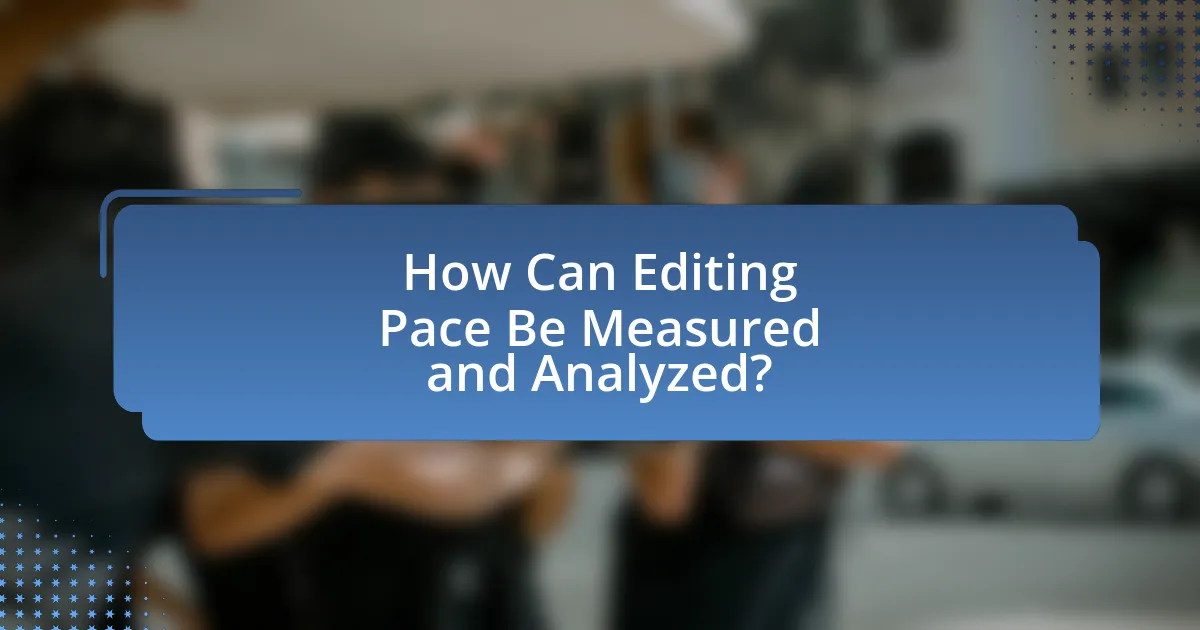
How Can Editing Pace Be Measured and Analyzed?
Editing pace can be measured and analyzed through quantitative metrics such as cuts per minute (CPM) and duration of shots, as well as qualitative assessments of viewer engagement and emotional response. Cuts per minute provides a numerical value indicating how frequently edits occur, which can correlate with the intensity of the narrative; for example, fast-paced editing often leads to heightened excitement or tension. Additionally, analyzing viewer retention rates and engagement metrics, such as comments and shares, can provide insights into how editing pace influences audience reactions. Research has shown that films with a higher CPM can lead to increased viewer engagement, as evidenced by studies that link rapid editing styles to higher adrenaline responses in audiences.
What metrics are used to assess editing pace?
Editing pace is primarily assessed using metrics such as edit duration, edit frequency, and viewer retention rates. Edit duration measures the length of time each edit remains on screen, while edit frequency counts the number of edits within a specific timeframe. Viewer retention rates indicate how well audiences maintain interest throughout the content, reflecting the effectiveness of the editing pace. Research has shown that optimal editing pace can significantly enhance audience engagement, with studies indicating that content with a balanced edit duration and frequency tends to retain viewers more effectively.
How do frame rates and cuts per minute influence editing pace analysis?
Frame rates and cuts per minute significantly influence editing pace analysis by determining the rhythm and flow of visual storytelling. Higher frame rates, such as 60 frames per second, create smoother motion, which can enhance the viewer’s immersion and engagement. Conversely, lower frame rates, like 24 frames per second, often evoke a more cinematic feel but may slow down the perceived pace.
Cuts per minute (CPM) directly affect the frequency of transitions between shots, with higher CPM indicating a faster editing pace that can generate excitement or tension, while lower CPM can create a more contemplative or dramatic atmosphere. Research indicates that films with a CPM of 30 or more tend to keep audiences more engaged, as they maintain a dynamic visual interest. Thus, both frame rates and cuts per minute are critical metrics in editing pace analysis, shaping how audiences perceive and react to the narrative.
What tools are available for measuring editing pace in films?
Tools available for measuring editing pace in films include software applications like Avid Media Composer, Adobe Premiere Pro, and Final Cut Pro, which provide features to analyze the duration of shots and transitions. These tools allow filmmakers to track the number of cuts per minute and the average shot length, which are critical metrics for understanding editing pace. Research indicates that a higher number of cuts per minute can correlate with increased audience engagement, as seen in studies analyzing viewer retention rates in fast-paced films.
How does audience feedback inform editing pace decisions?
Audience feedback directly informs editing pace decisions by providing insights into viewer engagement and emotional responses. For instance, if audience reactions indicate that scenes feel too slow or too fast, editors can adjust the pacing to enhance viewer retention and satisfaction. Research shows that films with a well-calibrated editing pace, aligned with audience preferences, tend to achieve higher ratings and box office success. This correlation highlights the importance of audience feedback in shaping editing choices to optimize engagement.
What methods are used to gather audience reactions to editing pace?
Methods used to gather audience reactions to editing pace include surveys, focus groups, and eye-tracking studies. Surveys allow researchers to collect quantitative data on audience preferences and perceptions regarding editing speed. Focus groups provide qualitative insights through discussions, enabling participants to express their feelings about pacing in a more nuanced manner. Eye-tracking studies measure visual attention and engagement, revealing how editing pace influences viewers’ focus on specific elements within a scene. These methods collectively offer a comprehensive understanding of audience reactions to editing pace, supported by empirical data from various studies in media psychology.
How can audience engagement metrics guide editing choices?
Audience engagement metrics can guide editing choices by providing data-driven insights into viewer preferences and behaviors. For instance, metrics such as average watch time, drop-off rates, and interaction rates reveal which segments of content resonate most with the audience. An analysis of these metrics can indicate that faster editing styles may retain viewer attention better in certain contexts, while slower pacing might be more effective for complex narratives. Research shows that videos with higher engagement rates often feature a dynamic editing pace that aligns with audience expectations, as evidenced by a study from Wistia, which found that videos with a higher editing frequency saw a 35% increase in viewer retention. Thus, leveraging audience engagement metrics allows editors to make informed decisions that enhance content effectiveness and viewer satisfaction.
What are best practices for optimizing editing pace for audience engagement?
To optimize editing pace for audience engagement, maintain a rhythm that aligns with the content’s emotional tone and complexity. Research indicates that varying the editing pace—using quick cuts during high-energy moments and slower transitions during reflective scenes—enhances viewer retention and emotional connection. For instance, a study by the University of Southern California found that fast-paced editing can increase excitement but may lead to cognitive overload if overused, while slower pacing allows for deeper processing of information. Balancing these techniques based on the narrative context ensures that the audience remains engaged without feeling overwhelmed.
How can filmmakers balance pacing to maintain viewer interest?
Filmmakers can balance pacing to maintain viewer interest by strategically alternating between fast and slow sequences to create emotional highs and lows. This technique keeps the audience engaged by preventing monotony and allowing moments of tension to build, followed by relief or resolution. Research indicates that films with varied pacing, such as “Mad Max: Fury Road,” which utilizes rapid cuts during action scenes and slower moments for character development, effectively sustain viewer engagement. This approach aligns with psychological studies showing that varied stimuli capture attention more effectively than uniform pacing.
What common pitfalls should be avoided when editing for pace?
Common pitfalls to avoid when editing for pace include excessive cutting, which can lead to a disjointed narrative, and neglecting character development, which may result in a lack of audience connection. Overly rapid transitions can confuse viewers, while inconsistent pacing can disrupt the flow of the story. Additionally, failing to balance action with quieter moments can diminish emotional impact. These pitfalls can hinder audience engagement, as research indicates that well-paced editing enhances viewer retention and emotional response.
